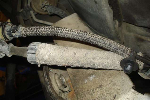Stick4503
Well-Known Member
- Joined
- December 12, 2011
- Messages
- 277
- Reaction score
- 9
- City, State
- Winder, Georgia
- Year, Model & Trim Level
- 1996 & 2004Explorer 4x4
I have posted about the explorer already but may have led people in the wrong direction. I know that I am going to have to replace / rebuild the engine at some point soon but I can't figure this out. Please help.
2004 Explorer 4 door. 4.0 SOHC
Has / had a head gasket coolant leak into number 4 cylinder. Runs hot on interstate. Runs fine around town.
Use Blue Devil pour and go head gasket repair. Seemed to work. No coolant in cylinder and running smooth until back on interstate. Ran hot again.
Back at home attempted leak down test on # 4. Air in coolant.
Attempted same test on #5 . Piston must not have been full TDC, engine turned backwards, tried a couple more times same result. Engine turned backwards every time. Not a lot just like the piston was pushed to the bottom of its stroke, but in reverse.
Gave up and pulled water pump to make sure it was working and not causing overheating. Its fine. Put everything back together.
Put a stronger Blue Devil head gasket repair product in and cranked it up so it could do its thing. Vehicle runs like crap. Way worse than ever before.
Idles bad. Engine shakes, wont get up to speed. Acts like it cant breath or something. If i just barely block the air intake in the air box, with two fingers, the engine dies.
So question is. Vehicle ran fine into the garage and now wont run well at all. Any ideas. I have checked everything I can think of. Nothing left loose.
This is our primary vehicle. I need to be able to get around town or at least be able to get it to a shop.
2004 Explorer 4 door. 4.0 SOHC
Has / had a head gasket coolant leak into number 4 cylinder. Runs hot on interstate. Runs fine around town.
Use Blue Devil pour and go head gasket repair. Seemed to work. No coolant in cylinder and running smooth until back on interstate. Ran hot again.
Back at home attempted leak down test on # 4. Air in coolant.
Attempted same test on #5 . Piston must not have been full TDC, engine turned backwards, tried a couple more times same result. Engine turned backwards every time. Not a lot just like the piston was pushed to the bottom of its stroke, but in reverse.
Gave up and pulled water pump to make sure it was working and not causing overheating. Its fine. Put everything back together.
Put a stronger Blue Devil head gasket repair product in and cranked it up so it could do its thing. Vehicle runs like crap. Way worse than ever before.
Idles bad. Engine shakes, wont get up to speed. Acts like it cant breath or something. If i just barely block the air intake in the air box, with two fingers, the engine dies.
So question is. Vehicle ran fine into the garage and now wont run well at all. Any ideas. I have checked everything I can think of. Nothing left loose.
This is our primary vehicle. I need to be able to get around town or at least be able to get it to a shop.











